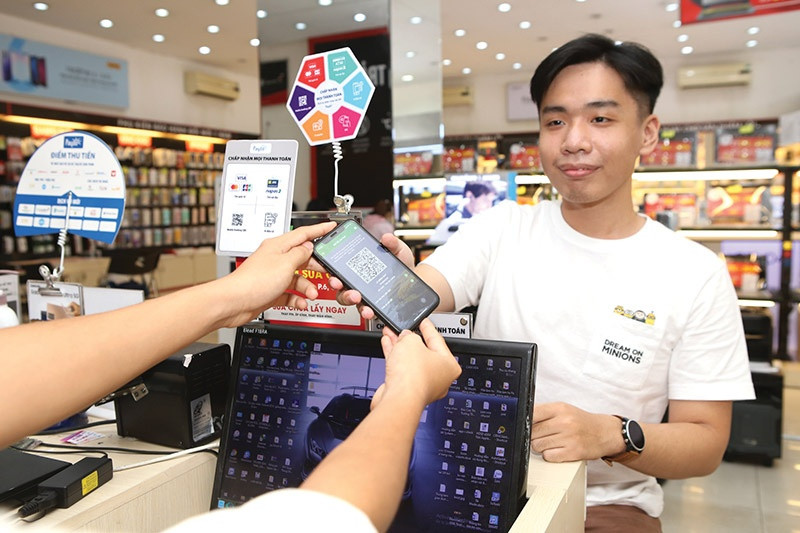Not only popular in commercial centres and supermarkets, but modern payment methods via internet banking, e-wallets, and QR codes are also now more likely to be accepted and deployed at both retail stores and street eateries.
 |
“I am very surprised to find that some sidewalk restaurants are going digital. Never before has the purchase of a loaf of bread, or a low-value snack, been done so easily,” said Quang Dang, a 23-year-old living in Ba Dinh district of Hanoi.
Nguyen Diep’s iced tea shop on the sidewalk of Chua Lang street in Dong Da district is an example. Any customer who buys a cup of iced tea or a few sweets worth only a few thousand VND can scan a QR code instead of using cash.
Diep has been using QR code payments for nearly two years, since people were advised by the government to avoid crowds and close contact and keep a safe distance during the pandemic. Now, Diep no longer wants to change back.
“The biggest advantage of cashless payments is that I do not have to prepare change to return to the customer. Buyers save time, and sellers easily control their financial situation because the amount transferred to the account is clearly notified,” Diep said.
In fact, online payment methods are growing at a fast rate and increasing coverage in all fields. According to statistics from the State Bank of Vietnam, non-cash payment transactions increased by 77 per cent in volume and 30 per cent in value in the first six months of this year; in which, via the internet increased 63 per cent and 32 per cent respectively; via mobile increased 98 per cent and 84 per cent respectively; and via QR code increased by 86 per cent and 127 per cent over the same period in 2021.
Ngo Anh Tuan, director of VNPAY-QR, said 85 per cent of consumers in Vietnam are using this payment method more often than two years ago. “Many popular ice tea shops in Hanoi and Ho Chi Minh City also accept QR payments,” Tuan said.
Statistics via the Payoo payment platform also show that the value of cashless payments in the second quarter grew strongly, especially in the fields of public services, education, tourism, food and beverages (F&B), retail, fashion, and electronics.
Specifically, the F&B industry increased by 61 per cent in volume and 41 per cent in transaction value compared to the first quarter of 2022. International cards have become the dominant payment method in this field, accounting for 64 per cent in volume and 77 per cent in value.
Meanwhile, payment transactions on the National Public Service Portal in Q2 increased by 84 per cent in volume and three times in transaction value compared to the first quarter.
This sector is expected to continue to make stronger leaps after Prime Minister Pham Minh Chinh in a recent meeting on financial inclusion ordered an acceleration of non-cash payment for public services. This includes collection and payment of taxes, fees, and charges as well as collection of fines for administrative violations and road toll collection by 2025.
Ngo Trung Linh, general director of VietUnion said, “The cashless payment market has ample room for development because Vietnamese users quickly adapt to digital payment services.”
Seizing this opportunity, Payoo in addition to providing payment solutions for public services also cooperates with partners, including Mastercard. Until now, Payoo has connected with more than 15,000 point-of-sale terminals to provide bills and collection of more than 350 types.
Online payment habit also creates growth opportunities for companies providing growth solutions. According to the National Payment Corporation of Vietnam, by the end of April, the transaction value of the interbank electronic payment system had increased by 32 per cent; mobile payments increased by 98 per cent in number of transactions and 87 per cent in value; and payments via QR code increased by 57 per cent in quantity and 111 per cent in transaction value.
Source: VIR